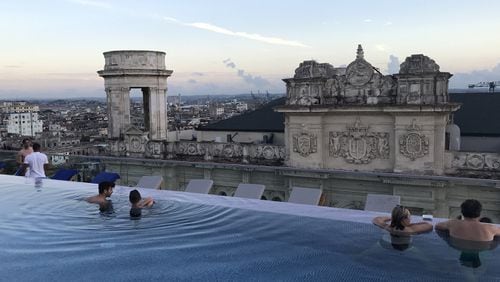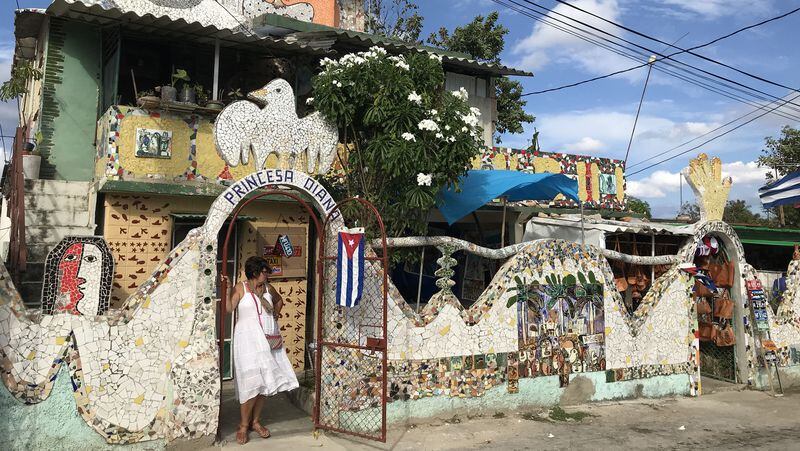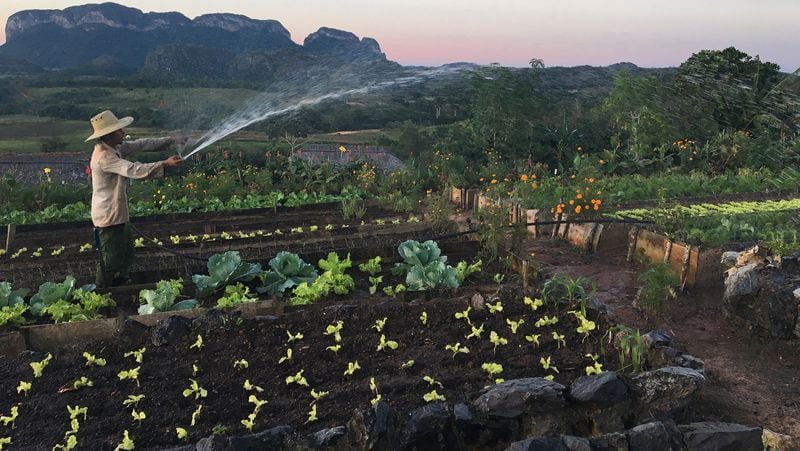VINALES, Cuba — “In Cuba, the plan is that few things will go according to plan.
“It’s essential that you arrive with an open heart, a curious mind and a supreme level of flexibility.
“Expect the unexpected … it’s all part of the adventure!”
These nuggets of wisdom — skeptics might call them warnings — were in the pre-departure packet that arrived in the mail a few weeks before my December bike trip in Cuba.
My husband and I, both avid fans of two-wheel travel, signed up for our cycling vacation before the Cuba situation started taking telenovela-like twists involving so-called sonic attacks, a State Department warning, confusing new travel restrictions and a hurricane named Irma.
“Are you sure you want to go?” my mom asked on more than one occasion.
The answer: absolutely.
Like many Americans, I’d long been fascinated by this forbidden tourist fruit, the largest of the Caribbean islands in both size and population. Isolated and enigmatic, Cuba had always commanded an air of being disproportionately foreign for a place so close to Florida, about as far away from Key West as Chicago is to Milwaukee. I wanted to see it for myself, to make sense of a hodgepodge of nouns I’d tacked on to Cuba like sticky notes over the course of a lifetime, from Castro, communism and Elian Gonzalez to cigars, mojitos and old American cars.
An opportunity to scratch this itch came when California-based active travel company Backroads expanded its Cuban offerings to include a new bike trip.
My imaginary tattoo says cycling is the best way to see a place. For a full-blown sensory experience, a bike saddle always beats a bus seat. The relaxed pace forces you to slow down and savor the moment. And you can cover a lot more ground cycling than walking.
So, with an open heart, curious mind, supreme level of flexibility — not to mention a fair bit of cash, since U.S.-issued credit and ATM cards are basically useless — we landed in Havana in early December, ready to expect the unexpected.
Credit: Lori Rackl
Credit: Lori Rackl
———
TIME TO ROLL
Our Backroads group, all 13 of us, rendezvoused as instructed outside the Gran Hotel Manzana Kempinski, a swanky, five-star property within stumbling distance of Hemingway’s favorite daiquiri joint, the Floridita.
The hotel opened to quite a bit of fanfare last summer in Old Havana, which isn’t exactly flush with luxury lodging.
Backroads had us staying at the Kempinski the last night of our six-day trip, but I wondered if this was going to be one of those plans that wouldn’t go according to plan. Citing the hotel’s ties to the Cuban military, the Trump administration had recently put it on a lengthy list of banned businesses off-limits to Americans.
Maybe we wouldn’t be able to cap off our vacation with a dip in the Kempinski’s rooftop pool after all.
I’d have time to contemplate this First World problem during our 2 1/2-hour motor coach ride from Havana toward the western tip of this narrow, tiger tail of an island. The lush countryside of the Pinar del Rio and Artemisa provinces is where we’d spend the bulk of the week, biking an average of 40 miles a day around the tobacco farms of the Vinales valley (a UNESCO World Heritage Site) and the forested hills of the environmentally minded commune Las Terrazas (part of a UNESCO biosphere reserve).
On the outskirts of the town of Vinales, our bus pulled up to an adorable thatched-roof restaurant, El Cuajani. The whitewashed building with bright blue trim looked especially diminutive in the shadow of the area’s famed mogotes, limestone monoliths covered in scrubby vegetation, like protruding chins sprouting 5 o’clock shadows.
Our bikes were waiting for us near rows of neatly planted beans. So was El Cuajani’s chef-owner, Jose, who greeted us with glasses of fresh-pressed sugar-cane juice.
While chickens roamed around the garden, Jose fed sugar-cane stalks through a contraption that squeezed the sweet syrup out of this key Cuban crop — one that resulted in countless slaves being brought here from west Africa.
Spanish colonists dubbed the area Vinales, thinking the terrain looked great for growing grape vines. Wrong. But the rich, rust-red soil proved ideal for tobacco. The plants’ fat, floppy leaves still carpet much of the region.
We biked from Jose’s restaurant down lightly trafficked streets flanked every now and then by concrete, pastel houses, where thin towels and T-shirts dried on laundry lines. The rare roadside billboard gave a shoutout to socialism or Cuba, as opposed to car dealerships and KFC. We maneuvered our wheels around rim-bending potholes and what felt like a veritable petting zoo. Cows, goats, horses, chickens, dogs — random animals were just part of the scenery, much like the omnipresent turkey vultures soaring low overhead.
I had the sensation of pedaling through a living history museum as we passed farmers tending to tobacco fields with ox-driven plows, as they’ve done for centuries. We shared the streets with clip-clopping horses pulling wagons of hay and exchanged holas and mutually curious glances with men in straw hats whacking tall grass with machetes.
We witnessed a lot of this type of timelessness in Cuba, a country simultaneously suspended in amber yet in the midst of unprecedented change. Only in the last decade have Cubans been allowed to own cellphones, buy and sell real estate, and travel abroad more freely. Later this year will be the first time someone not named Castro has led the nation since 1959, when the revolution swept Fidel, and eventually his brother, Raul, to long-lasting power.
In Mark Kurlansky’s riveting new book, “Havana: A Subtropical Delirium,” he notes a popular Cuban joke about the revolution, whose three great success stories are said to be health care, education and sports. Its three great failures? Breakfast, lunch and dinner.
I don’t think anybody goes to Cuba strictly for the cuisine, a fire hose of black beans, rice, plantains, poultry and pork. These staples surfaced on the menu every day, along with some variation of fish and the potatolike root vegetable malanga. Dessert was either flan or flan. It’s a culinary routine that could soon get old. But as a visitor here for a week of calorie-torching cycling, the protein-rich, starchy smorgasbord hit the spot.
Credit: Lori Rackl
Credit: Lori Rackl
———
WELCOME HOME
Some of the best things we ate were at Cubans’ homes, where Backroads arranged for us to take periodic breaks from biking for a little rest and refueling.
I loved rolling up to these houses to find pitchers of fresh-squeezed juice that would fetch $8 a glass back home in Chicago. Our smiling hosts invariably would be waiting for us with big platters of ripe tropical fruit — mango, pineapple, papaya. (Learned the hard way: Papaya means something very different in Cuba. Call it fruta bomba to avoid embarrassment all around.)
Our two Backroads guides, Lara and Pablo, were from Spain, but they’ve lived and worked in Cuba long enough to map out an impressive network of fixers and families willing to open their homes to hungry, sweaty foreigners. This meant a memorable lunch on the sunny patio of a fisherman’s humble, oceanfront abode, feasting on grilled red snapper he’d caught that morning. At another house, we snacked on wood-fired pizza as good as any I’ve had in Italy. Or maybe I just really missed pizza.
After biking a particularly challenging set of hills, we stopped at a sea-foam green house to sip the sweet insides of a coconut — an elixir that goes down even better while sitting on a front porch in a rocking chair, a ubiquitous piece of home decor in Cuba.
These visits always ended with an espresso-sized dose of dark, sweet Cuban coffee, the perfect rocket fuel to propel our legs up the route’s steeper sections.
Another perk of stopping at these homes was the chance to get a behind-the-scenes peek at domestic Cuban life. Glamour shots of sons and daughters hung on brightly painted walls. Thrift-shop-type furniture was arranged around boxy TVs. Vases sprouted plastic roses and lilies, despite a bounty of flowers blooming outside. Tidy, tiny kitchens often had the barest of necessities: a few coffee cups, plates, some pans, a slow cooker. In bathrooms, a toilet seat and lid weren’t necessarily a given.
Even many of the hotels — very good hotels by Cuban standards — aren’t comparable to the modern conveniences we take for granted in the States. After our first night at Los Jazmines, a pink, colonial-style property with stunning vistas of the emerald green Vinales valley, we woke to discover there was no water — and I’m not talking about an over-priced bottle of Evian on the minibar. I’m talking nothing coming out of the sink. No way to flush the toilet. Nada.
Hotel staff assured us the problem would be fixed by the time we got back from that day’s ride. It wasn’t.
Our guide Lara went into troubleshooting mode to find a solution for 13 cyclists in desperate need of showers before our fast-approaching dinner reservation. Talking a million miles a minute in a way that only Spanish speakers can, Lara negotiated our move to one of the hotel’s other buildings. The views weren’t quite as spectacular from our new rooms, but more importantly, the bathroom scenery included running water.
———
PREPARE TO PIVOT
Over the course of the week, Lara and Pablo had to do plenty of adjusting on the fly. Running a cycling trip in Cuba — or just about any trip — isn’t easy. That’s probably why they’re not cheap, either. Backroads’ five-night Cuba bike trips in 2018 start at $4,998 a person. This covers just about everything except airfare, alcohol and gratuities for Backroads guides.
It’s challenging to navigate the island’s infrastructure, from spotty cell and Wi-Fi service to chewed-up streets that can make for a teeth-chattering ride. Government rules are often fickle and in a state of flux, resulting in Lara and Pablo having to make some last-minute tweaks to our bike route in Vinales. Restaurants and other businesses aren’t always reliable partners.
In Cuba, the plan is that few things will go according to plan.








